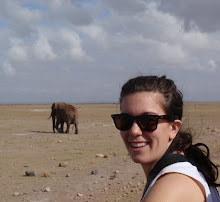Transcript of my notes from Part II of our safety lecture from the Student Affairs Manager about the danger of animals here in Kenya. Since the electric fence that surrounds our camp and the lands around it is no longer functional because people could not afford to pay for it, we have to look out for lots of animals not only in the field and camping out, but literally every day and night at KBC. Vigilance is the key.
Crocodiles.
Can launch selves nine feet out of the water
Buffalo.
Most dangerous. Pure muscle, big. Stupid. Try to avoid completely. Like to hide in bushes. Very aggressive.
Hippos.
Biggest killer of tourists in East Africa. Big, but fast for their small legs. Very mean. Ok when they’re in the water, very dangerous when you’re on land, especially if you’re between them and the water (their comfort zone).
Lions and predators.
Look them straight in the eye, stare them down. Slowly back away. When at a safe distance, turn and run like hell. Pretend like you’re bigger and more aggressive until you run.
Elephants.
Like buffalos, most aggressive ones are lone males, and mothers with babies. Don’t climb a tree, they can knock them down. Apparently run in zigzag, which confuses them. Can be very aggressive, particularly in parks.
Baboons and Monkeys.
In tourist sites they are very aggressive. They will take your Tupperware, open it, and eat it. In general will take your food if you hold it out. Best to just give it to them if they go for it. Close car openings because they will take it and leave their feces. Nothing you can do, don’t try to scare them off. They will scratch, bit, and give diseases.
Rhinos.
Run like hell.
Snakes. Askaris (guards) have to kill venomous snakes in student areas because they are very territorial, and they will come back. Have found Black Mambas at the Center. Back away from the snakes, don’t go running after them, don’t put face near them (apparently a lot of students have put themselves into serious danger by doing this). Baby snakes can be more dangerous because they’re still learning how to control their venom. Best thing to do if bitten is to fly you to Nairobi, but it takes 45 min to drive to the airstrip, then 1-2 hours flying, and some venom will kill you in 45 minutes.
Black Mamba.
Can strike from one yard away. Most dangerous if backed into tight corners. Not necessarily black. Easily confused with Brown House snake.
Egyptian Cobra.
Can spit, if it goes into your eyes it can cause you to go blind. Some say best treatment for spit on eyes in putting urine on eyes, but they don’t recommend it. Should just wash eyes with water.
Puff Adder.
Might not react to first person to come across it, but can get annoyed and attack next person.
If bitten: most of the time, venom is not released. Do not elevate the bitten limb. Apply pressure to limb, above and below bite area but not to tourniquet.
Avoidance: be aware of where you’re walking. Stick to paths at night. Wear closed-toed shores and long pants. Use flashlight. Leave tent and banda doors closed.
Other biting/stinging critters:
Scorpions.
Most not deathly, but might make you wish you’re dead from pain of bit.
Hairy caterpillars.
Hairs can get stuck in your skin.
Safari Ants.
Bites are painful. Don’t stand on anthills, they will crawl up your legs.
Vegetation.
Everything is pointy or thorny. Some (Acacia thorns) have poisons; wash and cover as response to puncture wounds.
________
Well that was about it. Unless you were wondering what Part I of this lecture was about. In case you are curious, it was all of the diseases we can get, from African Sleeping Sickness to Yellow Fever to Malaria--well, you get the picture.
Subscribe to:
Post Comments (Atom)





Andrew tuning in. Great title, but otherwise boring blog entry. Try to make your study abroad seem at least a little interesting. Love you.
ReplyDeleteI hope you have a machete.
ReplyDelete